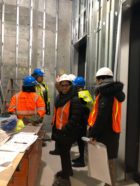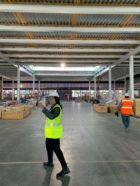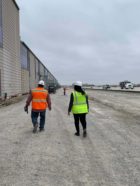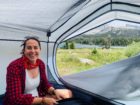I’m a first-generation immigrant from a tiny island called the Commonwealth of Dominica, in the Caribbean. My parents and most of my family are still there. I came to the U.S. to attend university and begin my career.
I credit my parents with exposing me to architecture at a young age. When I was a child, they enrolled me in art school, which I loved. Aside from learning painting and sculpture in the studio, we went out to paint some of the French Creole buildings which are all over my island. I thought these buildings were beautiful. They are part of my heritage.

My dad was not an architect, but he designed our house. Throughout the process, he would take me to the plot of land that he bought. I saw the foundation go in and the walls go up. I saw him choose every detail—the tiles, the roof material. It was fascinating. I don’t know if he realized at the time, but allowing me to tag along, to see the process of construction—that, combined with art school—convinced me that I could become an architect someday. I didn’t see a lot of women in the Caribbean practicing architecture, however. The people I saw were all men—my dad, his friends, the guys who worked in construction.
I studied building engineering on the island and I graduated first in my class. I got a scholarship to go to architecture school, and I had choices of where to study. I thought about going to Cuba or to Jamaica. I wanted exposure outside of the Caribbean, so I chose to move to the U.S. The scholarship wasn’t enough for full tuition, but it allowed me to enroll in a community college and then transfer to a bachelor’s program a couple of years later.
Arriving in New York, I experienced a bit of culture shock. It’s so different here from where I grew up. I would get on the city bus and say, “Good morning!” and people would just stare. Back home, you can’t get on a bus and not say good morning. Everyone will answer you.

I was busy those first months—figuring out how to find a job, figuring out how to dress for winter. I tried my best to make friends in order to learn. Not only to get through school, but to learn how to live here, how to find a room to rent, how to pay for the MTA—how to survive. All of that was very new to me.
I worked full-time while I was in school, and I had a few internships as well. I graduated in 2010, in the middle of the recession. I couldn’t find a job at a traditional architecture firm, but I landed a position working in store planning and retail design for Duane Reade, a pharmacy and retail chain now owned by Walgreens. It was a great experience. It allowed me to not only design healthcare-focused retail, but also to interact with leadership across many departments—marketing and merchandising, real estate and construction. I had to learn how to communicate with all of these different specialists.
My experience confirmed for me that I was interested in more than design—I wanted to understand the business side as well. Some of my colleagues told me: if you want to really lead within a global company, you need to know more than technical architecture. They encouraged me to earn a business degree to get a broader perspective. So, I went from there to Northeastern University, where I earned an MBA. I’m glad that I chose this path. I think it’s rare to find someone who has an education in both architecture and business.
I joined SOM in 2016. I started out working on interior architecture projects, and I made my way over to the architecture studio. I quickly got to contribute to large projects, like 35 Hudson Yards, which I loved. I also worked on the new cancer care center at Emory and on the Shanghai Marriott. Soon I started asking around: what is the path toward project management?


About a year ago, I got my first shot with the new international terminal at Kansas City Airport. For my first role at SOM as a project manager, getting to work closely with the management team on a $1.2 billion project—it blew my mind. The learning curve was steep, not only because of the size of the project, but because airport architecture is a very specific typology—there are many specialized terms, many agencies I had to become familiar with, and many consultants involved, all working within a highly progressive design-build process.

Our team is almost entirely women-led. Laura Ettleman is the managing partner. We meet with her multiple times a week—it’s very hands-on. Kirtan Patel is the senior associate principal and technical lead. Jennifer Finley is an associate principal. I joined the team under Linsday Allen, the project manager. I’ve learned so much from all of them.
Beyond my work, I’ve found a sense of community by getting involved in advocacy groups. I’m an active member of NOMA (National Organization of Minority Architects). In addition to being involved in this group within SOM, I served on the board of the organization’s New York Chapter (NYCOBA), in charge of finance management. One thing leads to another—I recently got elected to the Finance Committee of AIA New York and the Center for Architecture because of that involvement.
My work was featured in an exhibition called “Say it Loud,” organized by Pascale Sablan, at the 2018 AIA Conference in Las Vegas. I couldn’t afford to attend the conference, so I decided to work with the AIA as a volunteer. All of the volunteers wore lanyards with buttons you could collect across the conference. It was a great way to meet people—exchanging buttons and having conversations. I’m a shy person, and I wouldn’t have been able to make new friends if it wasn’t for those buttons. It gave me the inspiration for Architect Pins—a business that I’ve been growing during the pandemic.
The first pin I made says “Black Architect.” I created it as an icebreaker for others like me, but also as a way to further creating community within the AEC industry. I spoke at the 2019 NOMA conference in Brooklyn, and after the seminar, I sold my first pin out of my bag—I didn’t even have a website yet. Since then I’ve been working with a number of organizations to create custom pins—with Langan, American College of Healthcare Architects, Beyond the Built Environment, with several chapters of the AIA and NOMA, to name a few.
Last year I co-founded a new initiative at SOM, the Equity Design Lab. Our goal is to pursue more community-driven and collaborative projects while elevating equity within our work. We aim to deliver equitable, healthy and resilient built environments where communities can thrive. We’re taking this on from several different angles. One is providing resources for employees—we’re working on an equity toolkit for designers to use. We’ve had business strategy sessions and workshops with SOM’s partners, our practice leaders, and other groups throughout the firm. We collected a ton of data on what people thought about equity, and what the challenges may be toward achieving it.
We’re also looking to partner up with more diversified teams. For new project pursuits, our goal is to work with teams made up of a majority of BIPOC-led firms. We’ve had a lot of great feedback so far.
Another part is learning. We want to empower our colleagues to lead community engagement and strategy work—to have that inform our design, and then be empowered to go back for post-occupancy analyses to continue that cycle of positive impact. Our aspiration is to think of our projects as never really done, even once they’re built. It’s important to continue to be engaged and to understand how these built environments are serving their purpose.
By being involved in these organizations, you get to create and nurture your community. Your life as a professional can’t just be your 9-to-5. It really should be building connections with other people—seeing what they’re advocating for, how they’re making a positive impact. Through the Equity Design Lab, we’re able to make these connections. We’re able to have wider conversations that we hope will lead to positive change in the future.

In my own community, I’m the building committee chair at the Ephesus SDA Church, a historic church in Harlem. It’s a New York City landmark that was constructed in the 1880s. When I started going to this church a few years ago, I became aware that there were building and infrastructural issues to be addressed. The board needed architectural expertise, so I volunteered. At first, I was mostly listening; I wanted to understand what the issues were, who the key players were, what the finances looked like. Eventually I was able to create a schedule and a budget for the work that needed to be done—raising money, hiring the right architects, speaking with developers, speaking to community stakeholders. Now I’m leading a committee of 15 people. I think of them as project managers who are taking on different initiatives around the building and the Harlem community. The heritage of the church is so strong, and this work has been really important to me.
Through all of these experiences, I’ve connected with many like-minded people. I’ve also found people who don’t think like me, which I think is actually more important.
I’ve had another opportunity to engage with community issues through the Urban Design Forum, where I was selected as a 2021 Forefront Fellow. Our cohort is working with the Department of City Planning and with the Mayor’s office to investigate the issue of access to healthy and affordable food in New York City. So many people in the city are struggling with food security, even if they have full-time jobs. The pandemic proved that. Our goal is to propose policies that will positively impact food equity.
We started by doing in-depth research in various city neighborhoods—East New York, Mott Haven, and Elmhurst. We looked at the food infrastructure in these places, and we spoke with a ton of stakeholders—entrepreneurs, community gardens, farmers markets, urban farms, educators, and policymakers. We’ve been gathering data and insight to understand the gaps and the pitfalls that allow New Yorkers to be food insecure. With our research and with the tools we’re building, we will pitch our ideas for policy change in the summer of 2022. We’re hoping that the new mayor will adopt these policies.
Through all of these experiences, I’ve connected with many like-minded people. I’ve also found people who don’t think like me, which I think is actually more important. I like hearing about other people’s experiences and their journeys, because then you’re able to nurture empathy while communicating your own ideas more effectively.

My best advice to emerging design professionals is to remain curious. After you graduate from school, don’t get pigeonholed. Research different parts of the industry and try them out. Explore and figure out which parts of design you love and feel energized by, and that will steer you toward finding your purpose. I’m still on that journey, and I’m excited to see where it leads.
It’s been a few years since I’ve been back to visit Dominica, but every time I go home I’m checking back with the industry there, too. I even had the opportunity to give a radio interview to advocate for young women to pursue architecture and engineering. In the Caribbean, the number of women in the profession is still very low. There are a lot of misconceptions about what it means to be an architect. I want to show them that they can do it too.




